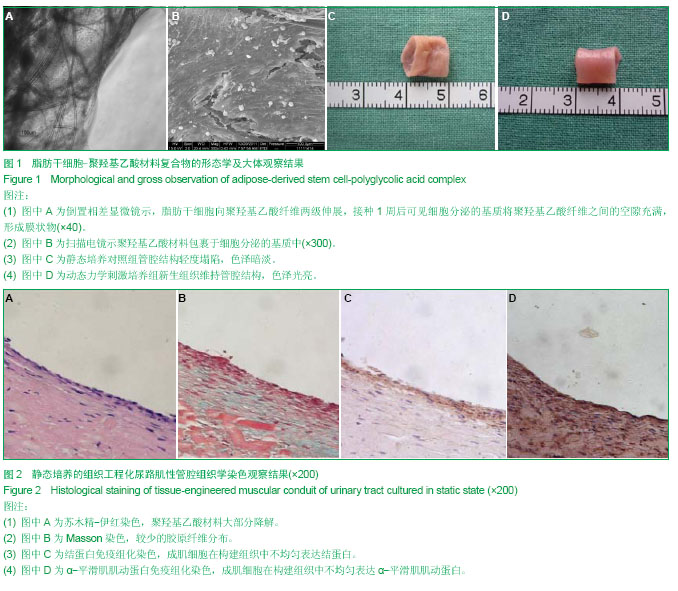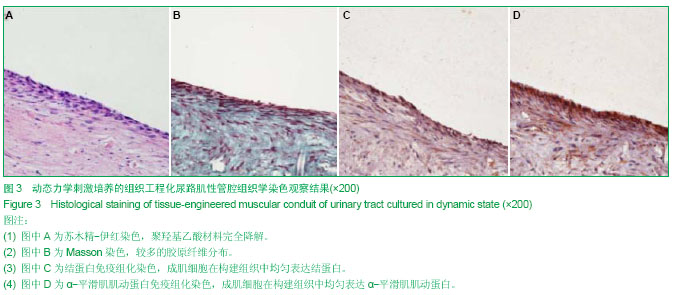| [1] Rehder P, Glodny B, Pichler R, et al. Dorsal urethroplasty with labia minora skin graft for female urethral strictures. BJU Int. 2010;106(8):1211-1214.[2] Mathur RK, Himanshu A, Sudarshan O. Technique of anterior urethra urethroplasty using tunica albuginea of corpora cavernosa. Int J Urol. 2007;14(3):209-213.[3] Marzorati G, Ghinolfi G, Pachera F, et al. Bladder and buccal mucosa graft in urethral stricture reconstruction. Urologia. 2008; 75(3):177-179.[4] Haque ME, Rahman MA, Islam MF, et al. Ventral free oral mucous membrane graft for bulbar urethral stricture. Mymensingh Med J. 2012;21(4):696-701.[5] Andrich DE, Mundy AR. Substitution urethroplasty with buccal mucosal-free grafts. J Urol. 2001;165(4):1131-1134.[6] 刘杰,傅强. Beagle犬上皮细胞原代培养鉴定及脂肪干细胞诱导成肌的实验研究[J]. 中华临床医师杂志:电子版,2011,5(10): 2864-2871.[7] Xu ZC, Zhang WJ, Li H, et al. Engineering of an elastic large muscular vessel wall with pulsatile stimulation in bioreactor. Biomaterials. 2008;29(10):1464-1472.[8] Atala A, Guzman L, Retik AB. A novel inert collagen matrix for hypospadias repair. J Urol.1999;162(3 Pt 2):1148-1151.[9] Farahat YA, Elbahnasy AM, El-Gamal OM, et al. Endoscopic urethroplasty using small intestinal submucosal patch in cases of recurrent urethral stricture: a preliminary study. J Endourol. 2009;23(12):2001-2005.[10] Fiala R, Vidlar A, Vrtal R, et al. Porcine small intestinal submucosa graft for repair of anterior urethral strictures. Eur Urol. 2007;51(6):1702-1708, 1708.[11] Dorin RP, Pohl HG, De Filippo RE, et al. Tubularized urethral replacement with unseeded matrices: what is the maximum distance for normal tissue regeneration? World J Urol. 2008; 26(4):323-326.[12] Raya-Rivera A, Esquiliano DR, Yoo JJ, et al. Tissue-engineered autologous urethras for patients who need reconstruction: an observational study. Lancet. 2011;377 (9772): 1175-1182.[13] Zhu Y, Liu T, Song K, et al. Adipose-derived stem cell: a better stem cell than BMSC. Cell Biochem Funct. 2008;26(6): 664-675.[14] De Ugarte DA, Morizono K, Elbarbary A, et al. Comparison of multi-lineage cells from human adipose tissue and bone marrow. Cells Tissues Organs. 2003;174(3):101-109.[15] De Ugarte DA, Alfonso Z, Zuk PA, et al. Differential expression of stem cell mobilization-associated molecules on multi-lineage cells from adipose tissue and bone marrow. Immunol Lett. 2003;89(2-3):267-270.[16] 符伟军,史建国,王晓雄,等. 人脂肪间充质干细胞诱导分化尿路上皮细胞的研究[J]. 中华实验外科杂志,2012,29(5): 927-929.[17] Rodriguez LV, Alfonso Z, Zhang R, et al. Clonogenic multipotent stem cells in human adipose tissue differentiate into functional smooth muscle cells. Proc Natl Acad Sci U S A. 2006;103(32):12167-12172.[18] Zuk PA, Zhu M, Ashjian P, et al. Human adipose tissue is a source of multipotent stem cells. Mol Biol Cell. 2002;13(12): 4279-4295.[19] Zuk PA, Zhu M, Mizuno H, et al. Multilineage cells from human adipose tissue: implications for cell-based therapies. Tissue Eng. 2001;7(2):211-228.[20] Williams KJ, Picou AA, Kish SL, et al. Isolation and characterization of porcine adipose tissue-derived adult stem cells. Cells Tissues Organs. 2008;188(3):251-258.[21] Cherubino M, Marra KG. Adipose-derived stem cells for soft tissue reconstruction. Regen Med. 2009;4(1):109-117.[22] Zaminy A, Ragerdi KI, Barbarestani M, et al. Osteogenic differentiation of rat mesenchymal stem cells from adipose tissue in comparison with bone marrow mesenchymal stem cells: melatonin as a differentiation factor. Iran Biomed J. 2008;12(3):133-141.[23] Wood JA, Chung DJ, Park SA, et al. Periocular and intra-articular injection of canine adipose-derived mesenchymal stem cells: an in vivo imaging and migration study. J Ocul Pharmacol Ther. 2012;28(3):307-317.[24] Kang JW, Kang KS, Koo HC, et al. Soluble factors-mediated immunomodulatory effects of canine adipose tissue-derived mesenchymal stem cells. Stem Cells Dev. 2008;17(4): 681-693.[25] Ryu HH, Lim JH, Byeon YE, et al. Functional recovery and neural differentiation after transplantation of allogenic adipose-derived stem cells in a canine model of acute spinal cord injury. J Vet Sci. 2009;10(4):273-284.[26] Martinello T, Bronzini I, Maccatrozzo L, et al. Canine adipose-derived-mesenchymal stem cells do not lose stem features after a long-term cryopreservation. Res Vet Sci. 2011;91(1):18-24.[27] Lim JH, Boozer L, Mariani CL, et al. Generation and characterization of neurospheres from canine adipose tissue-derived stromal cells. Cell Reprogram. 2010;12(4): 417-425.[28] 陈莉,杜锡光,赵保中,等. 聚羟基乙酸及其共聚物[J]. 高分子通报,2003,16(1):18-24, 52.[29] Bazeed MA, Thuroff JW, Schmidt RA, et al. New treatment for urethral strictures. Urology. 1983;21(1):53-57.[30] Olsen L, Bowald S, Busch C, et al. Urethral reconstruction with a new synthetic absorbable device. An experimental study. Scand J Urol Nephrol. 1992;26(4):323-326.[31] Atala A, Freeman MR, Vacanti JP, et al. Implantation in vivo and retrieval of artificial structures consisting of rabbit and human urothelium and human bladder muscle. J Urol. 1993; 150(2 Pt 2):608-612.[32] Lee RT, Schoen FJ, Loree HM, et al. Circumferential stress and matrix metalloproteinase 1 in human coronary atherosclerosis. Implications for plaque rupture. Arterioscler Thromb Vasc Biol. 1996;16(8):1070-1073.[33] Jockenhoevel S, Zund G, Hoerstrup SP, et al. Cardiovascular tissue engineering: a new laminar flow chamber for in vitro improvement of mechanical tissue properties. ASAIO J. 2002; 48(1):8-11.[34] Lee AA, Graham DA, Dela CS, et al. Fluid shear stress-induced alignment of cultured vascular smooth muscle cells. J Biomech Eng. 2002;124(1):37-43.[35] Niklason LE, Gao J, Abbott WM, et al. Functional arteries grown in vitro. Science. 1999;284(5413):489-493.[36] Engbers-Buijtenhuijs P, Buttafoco L, Poot AA, et al. Biological characterisation of vascular grafts cultured in a bioreactor. Biomaterials. 2006;27(11):2390-2397.[37] Gui L, Zhao L, Spencer RW, et al. Development of novel biodegradable polymer scaffolds for vascular tissue engineering. Tissue Eng Part A. 2011;17(9-10):1191-1200.[38] 郭清奎, 吕志前. 可完全生物降解材料聚乳酸-聚羟基乙酸复合壳聚糖在人工心血管支架制备中的应用[J]. 北京生物医学工程, 2011,30(6): 652-655. |


.jpg)